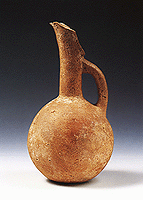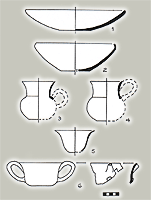

Toward the second half of the 3rd millenium intensive contacts between the eastern coasts of south Greece, the Cyclades and the northeastern Aegean take place (2450/2350-2200/2150). These are very clear in the ceramic production of the coasts of Asia Minor and the north Aegean (e.g. Troy, Poliochni on Lemnos, Palamari on Skyros), the Cylclades (e.g. Kastri on Syros, Skarkos on Ios) and of many EH coastal settlements (e.g. Pefkakia of Volos, Manika and Lefkandi of Euboea, Aegina, Lerna). The pottery of this phase is known as Lefkandi I-Kastri and is represented by handmade vases with red, brown or gray burnished surface. At the same time, the potter's wheel which is already used in the Near East and Asia Minor appears for the first time in the Helladic region and constitutes a milestone in the evolution of ceramic production in the Aegean. The new technology is applied to the manufacture of open bowls, which bear traces of a slow ceramic wheel. Apart from the shallow open bowls other characteristic vases are the bowls with curved rims, the one or two-handled cups, the depas amphikypello, the beak spouted globular jugs the wide mouthed jugs and the globular pyxides with incised decoration. In addition, even deeper bowls are made in the EH settlements which are known from the EH I and the early phase of EH II as well as the jugs of a trumpet shape (Trompettenkanne), which appear for the first time. Finally, coarse pottery includes cooking vessels and storage vases with incised and plastic or impressed decoration. |

|
|
|
Lefkandi. Shapes of
the "Lefkandi I" phase.
|
||
|
|
||